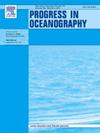佛得角(西北非洲)深海底栖生物群落的特征和制图
IF 3.6
3区 地球科学
Q1 OCEANOGRAPHY
引用次数: 0
摘要
以冷水珊瑚(CWC)和海绵为主的底栖生物群落增加了深海生态系统栖息地的复杂性和多样性,其特征类群是脆弱海洋生态系统(VMEs)的指标。西非边缘的许多地区仍未充分调查深海底栖生物群落的存在,从而限制了海洋空间计划的实施。本研究对佛得角西南部(西北非洲)的底栖生物群落,特别是Cadamosto海山(西南布拉瓦岛)以及福戈岛和布拉瓦岛的斜坡进行了特征和绘制,评估了两个系统(海山与岛屿斜坡)之间底栖生物群落组成的潜在差异。我们采用机器学习方法(多元回归树和随机森林分类),使用从2100至1450 m深度的遥控操作车辆(ROV)视频数据中获取的形态物种组成和密度数据,以及基材类型、地形和水柱参数的环境数据。研究区共鉴定出10个不同的底栖动物群落,以刺胞动物、多孔动物和棘皮动物为优势类群。与邻近岛屿坡面相比,海底山的cwc密度更高,物种丰富度更高。深度、基质类型、pH和溶解氧是影响生境异质性的关键环境变量。此外,还观察到由具有VME属性的特征分类群组成的群落,包括(i)海绵群落,(ii)核虫群落,(iii)八珊瑚和黑色CWC花园,以及(iv)海笔田。虽然研究区内捕鱼活动的影响明显较低,但在渔获物密度较高的地区,发现渔具遗失。这项研究为遵循预防原则在佛得角实施基于区域的养护措施提供了重要资料。本文章由计算机程序翻译,如有差异,请以英文原文为准。
Characterization and mapping of bathyal benthic communities of Cabo Verde (NW Africa)
Benthic communities, such as those dominated by cold-water corals (CWC) and sponges, contribute to the habitat complexity and diversity of deep-sea ecosystems, with characteristic taxa serving as indicators of Vulnerable Marine Ecosystems (VMEs). Many areas on the West African margin remain under-surveyed for the presence of deep-sea benthic communities and, hence, VMEs, limiting the implementation of marine spatial plans. In this study, the benthic communities of SW Cabo Verde (NW Africa), in particular Cadamosto Seamount (SW Brava Island) and the slopes of the islands of Fogo and Brava, were characterized and mapped, providing an assessment of the potential differences in benthic community composition between the two systems (seamount vs island slopes). We employed machine learning approaches (multivariate regression trees and a Random Forest classification) using data on morphospecies composition and densities retrieved from Remotely Operated Vehicle (ROV) video data collected from 2,100 to 1,450 m depth, as well as environmental data on substrate type, terrain, and water column parameters. Ten different benthic communities were identified in the study area, with cnidarians, porifera, and echinoderms as the dominant taxa. Higher densities of CWCs and communities with higher species richness were observed on the seamount compared to the adjacent island slopes. Depth, substrate type, pH and dissolved oxygen were identified as the key environmental variables driving habitat heterogeneity. Additionally, communities composed of characteristic taxa with VME attributes were observed, including (i) sponge aggregations, (ii) scleractinian, (iii) octocoral and black CWC gardens, and (iv) sea pen fields. Despite the apparent low impact of fishing activities in the study area, lost fishing gear was noted in areas where CWCs were observed in higher densities. This study provides important information for the implementation of area-based conservation measures in Cabo Verde, following the application of the precautionary principle.
求助全文
通过发布文献求助,成功后即可免费获取论文全文。
去求助
来源期刊

Progress in Oceanography
地学-海洋学
CiteScore
7.20
自引率
4.90%
发文量
138
审稿时长
3 months
期刊介绍:
Progress in Oceanography publishes the longer, more comprehensive papers that most oceanographers feel are necessary, on occasion, to do justice to their work. Contributions are generally either a review of an aspect of oceanography or a treatise on an expanding oceanographic subject. The articles cover the entire spectrum of disciplines within the science of oceanography. Occasionally volumes are devoted to collections of papers and conference proceedings of exceptional interest. Essential reading for all oceanographers.
 求助内容:
求助内容: 应助结果提醒方式:
应助结果提醒方式:


